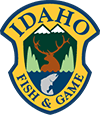Quail
HABITAT
Dense shrub vegetation at low to adjacent elevations or agriculture fields.
TASTE
Tender, white meat. Similar flavor to chicken. Excellent table fare.
ABUNDANCE
Good populations along rivers and streams with brushy cover below 3,500 feet in elevation.
LICENSE, TAGS AND PERMITS NEEDED
Valid Idaho hunting license.
SPECIES INFORMATION
Four species of quail occur in Idaho: California, Gambel’s, and mountain quail, and northern bobwhite. California quail are the most abundant and comprise almost all of the state’s quail harvest.
For all quail species, abundance is influenced by a combination of habitat availability and quality, and patterns and timing of rainfall. Although weather conditions during winter, nesting, and brood-rearing periods may cause large annual fluctuations in quail populations, long-term trends in abundance are generally determined by habitat quantity and quality. A wide array of factors influence habitat conditions, including certain farming practices (e.g., mowing pivot corners and fence-lines, crop conversion from small grains), livestock grazing, fire, and urban expansion. However, snow conditions often reduce availability of adequate winter foods, thus limiting quail distribution.
Dense shrub vegetation is an important component of quail habitat for roosting, winter, and escape cover. Quail are primarily herbivorous, consuming seeds, fruits, flowers, and green vegetation; invertebrates are also consumed, mostly by adult females and young chicks.
California Quail
California quail were introduced into Idaho, probably as early as the late 1800s. They occur in the northern, south-central, and southwestern portions of the state. California quail are highly dependent on protective, brushy escape cover. In some areas of their range in Idaho, rocky outcrops also provide escape cover. In addition, quail require a mix of open feeding areas and dependable water sources. Access to water is critical in summer and autumn when quail chicks are young, before winter precipitation begins. California quail diets consist primarily of broad-leafed plants and seeds Invertebrates are utilized to varying degrees by location and availability, but comprise a major portion of young quail diets.
Land use practices can dramatically affect California quail abundance. Appropriate levels of grazing, adequate sources of water, farming practices that leave cover, maintenance of adequate brushy escape cover, management of fire and logging, and disking to provide open habitat and promote preferred food growth have been shown to potentially increase California quail numbers. The range of California quail in Idaho likely expanded in concert with land-use changes such as flood irrigated farmland, animal feed lots, and increases in weedy annuals; however, as irrigation methods transition from flood irrigation to center-pivot irrigation, the range of quail is likely to constrict. California quail populations continue to thrive in increasingly urbanized areas where they are often fed during winter.
California quail are usually found in coveys, except during breeding-nesting season when they typically exhibit a monogamous breeding strategy. Quail will renest a second or third time if a nest is destroyed before hatching. Broods from renesting attempts will hatch later, and are typically smaller than initial nest attempts. Additionally, the male may care for the first brood while the female produces a second clutch.

